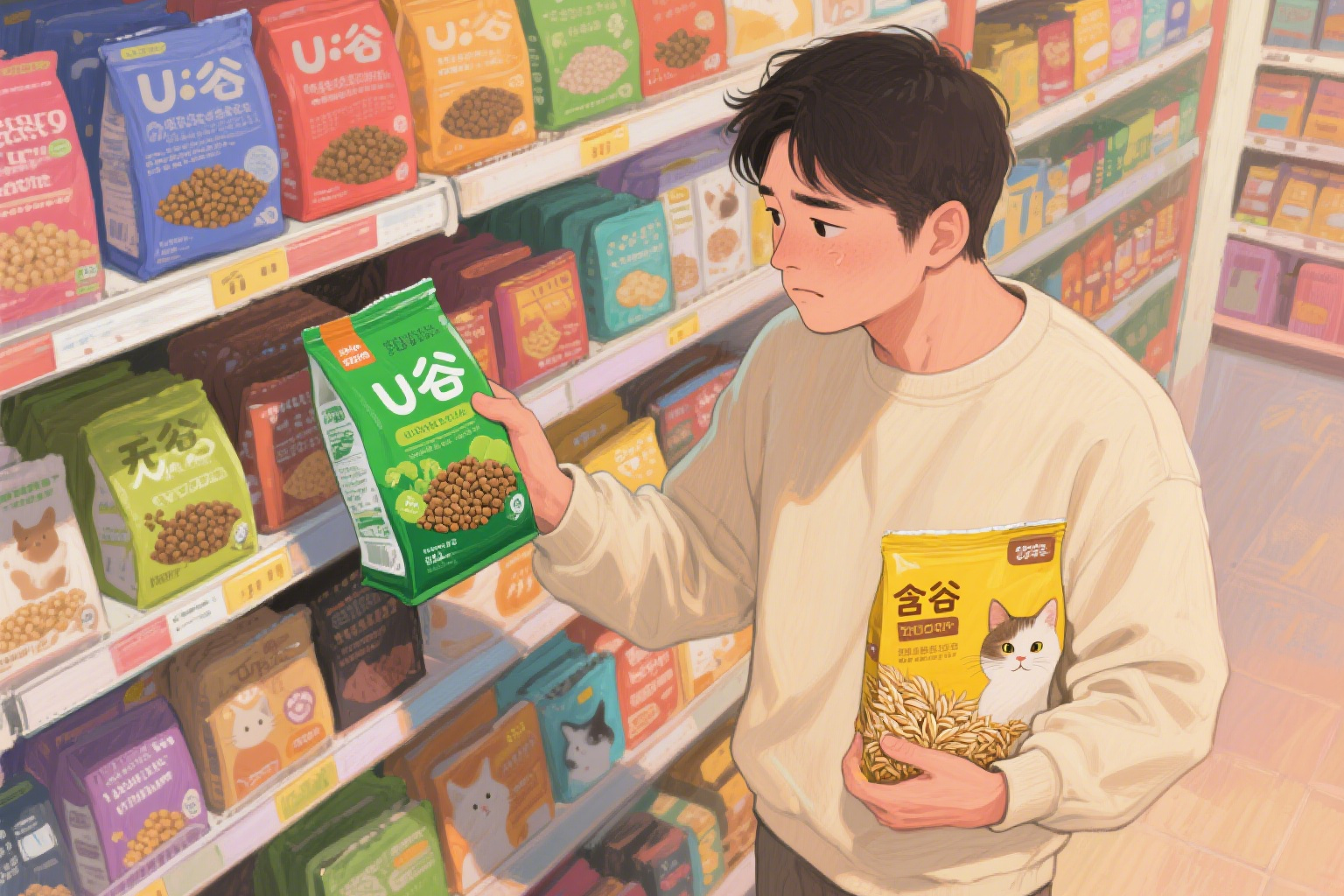Walk into any pet store, and you’re immediately hit by a wall of choices. Among the shiniest bags, one term shouts the loudest: Grain-Free. It’s marketed as the peak of feline nutrition, the ancestral diet your apartment cat secretly craves. But as a caring cat parent, you have to wonder, is grain-free cat food better, or is it just savvy marketing?
At AptPaws, we believe in making informed decisions, not just following trends. This science-backed guide will break down the grain-free cat food pros and cons, answer the core question эволюция do cats need grains, and help you choose the best diet for your feline family member.

Table of Contents
First, What Exactly IS Grain-Free Cat Food?
Before we can judge it, let’s define it. “Grain-free” simply means the food does not contain common grains like corn, wheat, soy, barley, or rice.
However, “grain-free” does not mean “carbohydrate-free.” To bind the kibble together and provide energy, manufacturers replace grains with other carbohydrate sources. These often include:
- Potatoes and sweet potatoes
- Peas and lentils
- Tapioca
- Chickpeas
So, the fundamental question isn’t just about removing grains, but about what they are being replaced with and if that change is genuinely beneficial.
The PROS: The Argument for a Grain-Free Diet
The marketing for grain-free food is powerful because it’s built on a few compelling, partially true arguments.
1. Cats are “Obligate Carnivores”
This is the scientific cornerstone of the grain-free movement. An “obligate carnivore” means your cat’s body is biologically optimized to get its nutrients from meat. Their digestive systems are short and acidic, perfect for breaking down animal protein and fat, not for fermenting large amounts of plant matter. Proponents argue that a grain-free, high-protein diet more closely mimics the ancestral diet of wild cats.
2. The Allergy Argument
Many owners switch to a grain-free diet because they suspect their cat has a food allergy. It’s true that some cats can be allergic to certain grains. However, this is less common than you might think. Scientific studies have repeatedly shown that the most common feline food allergens are the proteins, not the grains. The top culprits are often:
- Chicken
- Beef
- Fish
- Dairy
Switching to a grain-free food might solve an allergy problem, but it could be because the new food also switched the protein source (e.g., from a chicken-based to a salmon-based food), not because it eliminated grains.
The CONS: The Surprising Downsides and Controversies
Here’s where the story gets more complicated. What was once seen as a clear nutritional upgrade now has some significant counterarguments.
1. Still High in Carbohydrates, Just Different Ones
Remember those potatoes and peas? They are dense in carbohydrates. Some grain-free formulas can have carbohydrate levels that are equal to, or even higher than, grain-inclusive foods. For cats prone to obesity or diabetes, this is a critical point to consider. The source of the carbohydrate changed, but the quantity may not have.
2. The Potential Link to a Serious Heart Condition (DCM)
This is the biggest controversy surrounding grain-free diets. In recent years, the U.S. Food and Drug Administration (FDA) has been investigating a potential link between certain diets—many of them labeled “grain-free”—and a heart condition in pets called Dilated Cardiomyopathy (DCM).
The investigation is complex and ongoing. The correlation is strongest with diets that feature high levels of peas, lentils, other legume seeds, and/or potatoes as main ingredients. It’s not a proven cause-and-effect link, and the issue is not present in all grain-free foods. However, it has made many veterinarians cautious about recommending these diets universally without a specific medical reason.
3. Often More Expensive
Good marketing and premium ingredients often come with a higher price tag. You might be paying more for a perceived benefit that isn’t scientifically proven to be superior for most cats.
The Core Question: So, Do Cats Need Grains?
Let’s answer this directly: No, cats do not have a biological requirement for grains.
But here’s the crucial follow-up: They also don’t have a biological requirement for potatoes or peas. What cats do need are the nutrients that ingredients provide.
Grains, when properly cooked and used in appropriate amounts, are a digestible source of carbohydrates for energy and can provide other useful nutrients like fiber, vitamins, and fatty acids. The focus shouldn’t be on demonizing a single ingredient category. Instead, it should be on the overall nutritional profile of the food.
The best cat foods—whether grain-free or grain-inclusive—will be:
- High in named animal protein (e.g., “Deboned Chicken,” not “Meat By-products”).
- Balanced with the necessary fats, vitamins, and minerals.
- Formulated to meet the standards set by AAFCO (The Association of American Feed Control Officials).
The Verdict: What Should You Do for Your Cat?
So, is grain-free cat food better? For the vast majority of healthy cats, there is no scientific evidence to support that claim.
Here’s how to make the best decision for your cat:
- Look Past the “Grain-Free” Hype: Instead of focusing on what’s not in the food, focus on what is in it. Check the first five ingredients—they should primarily be high-quality animal proteins.
- Consider Your Cat’s Individual Needs: If your cat has been specifically diagnosed with a grain allergy by a veterinarian, then a grain-free diet is an excellent choice. For most cats, it’s unnecessary.
- Check for the AAFCO Statement: Look for a label on the bag that says the food is “complete and balanced” for your cat’s life stage (e.g., kitten, adult, senior).
- When in Doubt, Ask Your Vet: Your veterinarian is your most valuable resource. They understand your cat’s specific health profile and can recommend a diet based on science and experience, not just marketing trends.
Ultimately, the goal is a healthy, thriving cat. That can be achieved with both high-quality grain-inclusive and carefully chosen grain-free foods. The key is to be a savvy, informed pet parent.